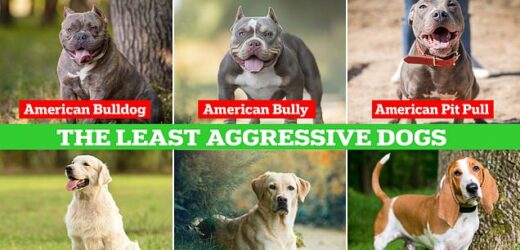The most AGGRESSIVE dog breeds revealed – so is YOUR pooch on the list?
- Researchers found that fighting dogs are the most aggressive
- This includes American Bulldogs, Pit Bull Terriers and Staffordshire Terriers
- Golden Retrievers, Labrador Retrievers and Scenthounds are least aggressive
Despite being referred to as ‘man’s best friend’, many dogs have an aggressive side.
And now a new study has pinpointed exactly which breeds are most likely to be aggressive towards other dogs.
Somewhat unsurprisingly, researchers from the University of Helsinki found that fighting dogs are the most aggressive.
This group includes American Bulldogs, American Pit Bull Terriers and American Staffordshire Terriers.
In contrast, Golden Retrievers, Labrador Retrievers and Scenthounds were found to be the least aggressive dogs.
Somewhat unsurprisingly, researchers from the University of Helsinki found that fighting dogs are the most aggressive. This group includes American Bulldogs (pictured), American Pit Bull Terriers and American Staffordshire Terriers
In the study, the team set out to investigate the personality differences between dog breeds.
‘The breed of the dog is the most important determinant underlying personality differences,’ said Dr Milla Salonen, lead author of the study.
‘All dogs are individuals, and all breeds have different traits, but the breeds differ in what kind of personality most dogs within each breed have.’
The team collected an enormous behavioural survey dataset containing information on 11,000 dogs across 300 different breeds.
These were then categorised into 52 groups.
The most aggresive groups of dogs
The least aggressive groups of dogs
The data revealed a strong link between breed and seven personality traits – insecurity, training focus, aggressiveness/dominance, energy, dog sociability, human sociability, and perseverance.
‘Dogs scoring high in aggressiveness/dominance are aggressive to other dogs, dominant, and territorial,’ Dr Salonen told MailOnline.
‘Whereas dogs scoring low are submissive, social with other dogs, and calming.’
Fighting dogs were revealed as the group with the highest levels of aggression.
This group includes American Bulldog, American Bully, American Pit Bull Terrier, American Staffordshire Terrier, Cane Corso, Dogo Argentino and Presa Canario.
Golden Retrievers (pictured), Labrador Retrievers, Scenthounds and Shetland Sheepdogs were found to be the least aggressive groups
Also at the top of the list were German Shepherds, Parson type terriers and Asian primitive dogs.
At the other end of the scale, Golden Retrievers, Labrador Retrievers, Scenthounds and Shetland Sheepdogs were found to be the least aggressive groups.
Aside from breed, several other factors were found to be linked to a dog’s aggression.
Male dogs were found to be more aggressive than females, while dogs were most aggressive at age nine.
‘Based on our research, personality traits are extremely complex and have astounding similarities between dogs, humans and other animals,’ Dr Salonen added.
WHAT ARE THE TEN COMMONLY HELD MYTHS ABOUT DOGS?
It is easy to believe that dogs like what we like, but this is not always strictly true.
Here are ten things which people should remember when trying to understand their pets, according to Animal behaviour experts Dr Melissa Starling and Dr Paul McGreevy, from the University of Sydney.
1. Dogs don’t like to share
2. Not all dogs like to be hugged or patted
3. A barking dog is not always an aggressive dog
4. Dogs do not like other dogs entering their territory/home
5. Dogs like to be active and don’t need as much relaxation time as humans
6. Not all dogs are overly friendly, some are shyer to begin with
7. A dog that appears friendly can soon become aggressive
8. Dogs need open space and new areas to explore. Playing in the garden won’t always suffice
9. Sometimes a dog isn’t misbehaving, it simply does not understand what to do or what you want
10. Subtle facial signals often preempt barking or snapping when a dog is unhappy
Source: Read Full Article




